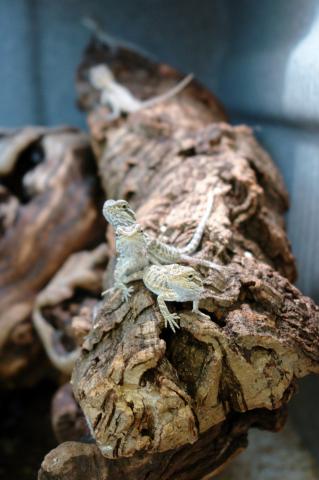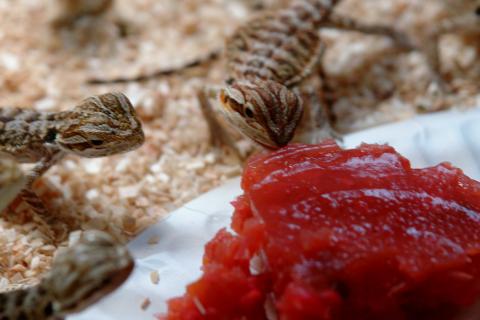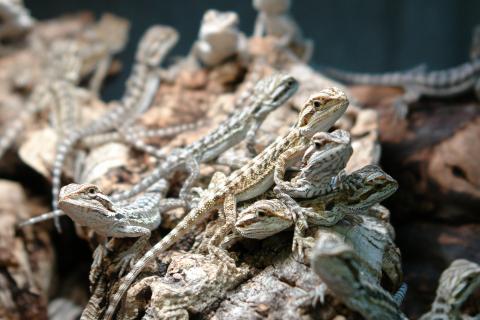Bearded Dragon
If you liked this article, then LIKE this article here!
- Common Name: Bearded Dragon
- Scientific Name: Pogona vitticeps
- Distribution: Australia
- Size: 2'
Natural History
The inland bearded dragon is a medium sized lizard hailing from the hot, dry deserts of central Australia. These diurnal lizards are quite at home in this harsh environment, and are well adapted to a desert lifestyle. When they get too hot, bearded dragons will actually bask with their mouths wide open, almost like a panting dog! This allows for salivary evaporation to take place, ultimately resulting in cooler body temperatures.
Naturally occuring bearded dragons range in color form dark brown and grey to orange and red. These colored individuals (typically found in environments with similarly hued soil) have been selectively bred for generations to produce a variety of exciting color morphs ranging from nearly white animals to ones that are completely red and orange!
Although male-male combat is often observed among sexually mature individuals, bearded dragons are in fact a social lizard, and interact favorably with others of their species (save for the exception noted above) and with humans as well. They are one of the few species of lizards that are naturally tame, that is, they will sit happily on your hand or shoulder with no intentions of biting, scratching, or running away.
Recommended Reading
Size and Longevity
With few exceptions, male bearded dragons get bigger than females, with some massive individuals topping out at nearly 2 feet. However, on average, adult bearded dragons will be between 16" and 22", although even smaller animals are regular reported..
For many years it was assumed that an acceptable captive life span for a bearded dragon was between 5 and 7 years. Luckily, as a result of improved husbandry techniques, and an overall better understanding of dragon biology, life spans exceeding 10 years are no longer uncommon.
Housing
Even as adults, bearded dragons can be housed in reasonably sized all glass enclosures. Although they do not require as much room as similarly sized, more active species, this attribute should not be abused and you should still provide your lizard with as much space as you possibly can.
Babies can be started in enclosures as small as 10 gallons, but keep in mind that these lizards grow incredibly fast, and will outgrow such an enclosure within a month or two. A 30 to 36 inch long tank around 12 inches deep would be a good size to start with, and should comfortably house your pet for its first 6 months of life.
Adults should have a tank at least 3 feet long, with a four foot long cage being preferable.
Heating and Lighting
As a desert species, these lizards like a lot of heat and light. Daytime basking temperatures may safely approach 105 degrees or more as long as the rest of the enclosure stays cooler. This ambient temperature should be 80 degrees or slightly less. Use of basking bulbs or ceramic heat emitters are ideal ways to provide the type of heat that this species requires.
Nighttime temperatures should not drop below 72 degrees for baby dragons, and no less than 68 for adults. Admittedly, a few cooler nights will likely cause no harm to these lizards, but it is always better to be safe than sorry.
Bearded dragons are a diurnal basking species, and as such, require exposure to full spectrum light in order to properly synthesize vitamin D3 and for calcium absorption in the GI tract. Specifically, light in the UVB range is required. In nature, the sun would provide these rays, but in captivity we must rely on fluorescent bulbs designed specifically for this purpose.
New mercury vapor bulbs such as ZooMed's Powersun are a new way to provide heat and UVB in one bulb. This form of light encourages a more natural range of behaviors, and the high amount of UVB emitted from these bulbs has been shown to promote healthy growth and even reverse minor cases of metabolic bone disease.
Substrate and Furnishings
The ideal substrate for bearded dragons is one that is lightweight, easy to clean, and cheap to replace, not to mention safe for the animals. There is heated debate over what bedding is best, and which should never be used.
In our experience, Sani Chips (an aspen chip substrate) has worked wonderfully and is our top choice for bearded dragons. Other beddings may be used, but follow the manufacturers directions for use, and be very careful about any small bedding particles with young lizards, as ingestion and impaction may occur.
Water and Humidity
Humidity should be kept low for these lizards, and typically the levels in the average home are fine. A light, daily spray with water may aid in the shedding process and will allow your lizard to lap up some of the droplets that form on the cage walls and decorations.
A water dish should be present, although as with many desert lizards, bearded dragons will rarely utilize a dish of water. However, it is an easy enough thing to provide, and will ensure that your lizard can drink if it really wants to.
Nutrition
Bearded dragons are omnivores, eating many types of insects and plant matter. In captivity, a diet of appropriately sized crickets, mealworms, roaches and a variety of dark, leafy greens should make up the majority of the diet. Packaged diets such as ZooMed canned Bearded Dragon Food and RepCal Bearded Dragon Food are excellent additions to your dragon's diet. If live foods are too much of a hassle, bearded dragons easily learn to eat canned insects off of steel tongs, as long as they're a little hungry and a little patience is involved!
These lizards will eat a lot, especially during their growth stage. Every bearded dragon is different, and will have slightly different preferences and eating habits. Keep in mind that you can feed them as much as they want to eat as long as it is part of a varied diet, and they are not allowed to become obese.
As a general rule, provide all ages of dragons with a salad of dark veggies every day. These veggies may include collard greens, mustard greens, kale, romaine lettuce, etc. Fruits such as apples, bananas, and figs may be offered occasionally as well. During winter, use of canned fruit or a nutritionally balanced canned diet can be an easy way to vary your dragon's diet when fresh veggies are hard to find.
Insect prey should be size appropriate and offered in quantities no larger than what the lizard will consume in an hour or so. Baby beardeds will easily eat 10 small crickets multiple times a day, while adults will be content with a bowl of giant mealworms and a handful of big crickets 4 times a week. Large adults may be fed the occasional pinky or fuzzy mouse for variety. If the chirping of crickets is an annoyance you don't want to deal with, large adult dragons can feed on large cockroaches, especially hissing roaches and dubia roaches.
All food should be lightly dusted with a calcium/vitamin D3 supplement at every feeding for babies, and every other feeding for adults. A high quality reptile multivitamin is highly recommended, and should be used as per the manufacturers instructions.
Handling
Bearded dragons are, as a general rule, as close to "friendly" as a reptile can be. They can be picked up and handled with little effort, although very young dragons may be frightened at first, and should be kept close to the floor in case of a sudden dash.
As with any animal, care should be taken that you do not stress your bearded dragon with excessive handling. Although rare, it is possible that a young dragon, or one not accustomed to human contact may become stressed and uninterested in food if over handled. Simply pay attention to the signals that the animal is sending you, and you should have a long, happy relationship with your pet.
© LLLReptile & Supply, Inc 2006







